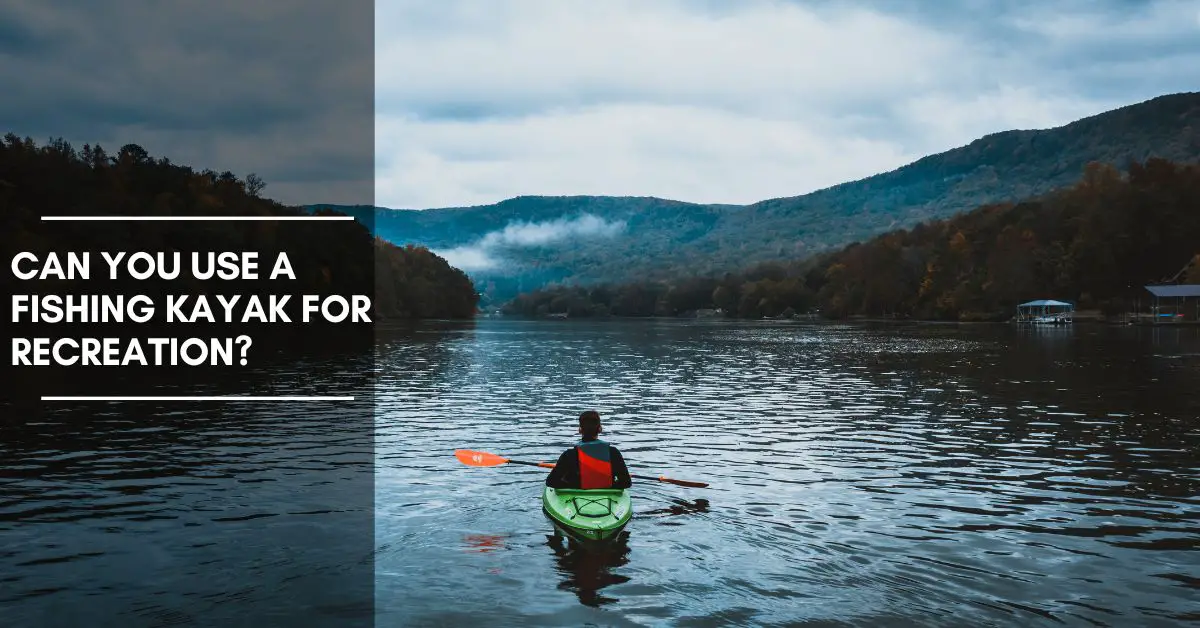Fishing kayaks have become increasingly popular in recent years, offering anglers an affordable and versatile way to reach their favorite fishing spots. But can you use a fishing kayak for recreational purposes as well?
In this article, we’ll explore the ins and outs of fishing kayaks and their suitability for recreational use. We’ll answer this question right away – yes, you can. But to understand why and how, let’s dive into the world of fishing kayaks and discover how they can enhance your outdoor experiences.
A fishing kayak is an excellent option for recreational activities, providing a versatile and cost-effective way to enjoy the great outdoors. The various features and designs of fishing kayaks allow for customization and adaptability, making them suitable for both fishing and leisurely paddling adventures.
So, let’s take a closer look at fishing kayaks, their unique features, and how you can maximize their potential for recreational fun.
Fishing Kayak Features and Versatility
Understanding Fishing Kayak Design
Fishing kayaks come in various shapes and sizes, with specific features tailored to the needs of anglers. However, these features can also make them highly adaptable for recreational use.
Sit-on-Top vs. Sit-Inside Kayaks
Fishing kayaks are available in both sit-on-top and sit-inside designs. Sit-on-top kayaks offer more stability and are easier to get in and out of, making them perfect for recreational activities like swimming and snorkeling. Sit-inside kayaks provide a more enclosed feeling and better protection from the elements, ideal for those looking for a more traditional kayaking experience.
Adapting Your Fishing Kayak for Recreational Use
While fishing kayaks are designed with anglers in mind, they can be easily adapted for recreational use with a few simple modifications.
Removing Fishing Gear
Many fishing kayaks come equipped with rod holders, tackle storage, and other fishing-specific features. To convert your fishing kayak for recreational use, you can remove or stow these items, freeing up space for more leisurely activities.
Adding Comfort Features
Fishing kayaks often have adjustable seats and footrests, but you can also add extra cushioning or back support for increased comfort during non-fishing outings.
Recreational Activities You Can Enjoy on a Fishing Kayak
Fishing kayaks are versatile vessels that can be used for a variety of recreational activities.
Paddling and Exploring
Fishing kayaks are designed for stability and maneuverability, making them perfect for leisurely paddles through calm waters or exploring secluded coves and inlets.
Wildlife Watching
The quiet nature of kayaks makes them ideal for observing wildlife in their natural habitats without disturbing them. Paddle close to shorelines, marshes, or estuaries for a chance to see birds, fish, and other marine life up close.
Photography and Videography
The stability of fishing kayaks also makes them an excellent platform for capturing stunning photos or videos of your adventures.
Conclusion
Fishing kayaks are versatile and adaptable, making them an excellent option for both anglers and recreational paddlers. By removing fishing-specific gear and making a few simple modifications, you can easily convert your fishing kayak into a vessel perfect for exploring, wildlife watching, and other leisurely pursuits. So go ahead, grab your paddle, and start enjoying the great outdoors in your fishing kayak!
FAQs
- Can I use a fishing kayak for whitewater or rough water conditions? Fishing kayaks are typically designed for calmer waters and may not be suitable for whitewater or rough water conditions. Always consult the manufacturer’s guidelines and use caution when venturing into challenging environments.
- Do I need any special permits or licenses to use a fishing kayak for recreational purposes? Generally, you do not need a special permit or license to use a fishing kayak for non-fishing activities. However, some localities may require registration or permits for kayaks used on specific waterways, so it’s essential to check local regulations before heading out.
- Are fishing kayaks suitable for beginners? Yes, fishing kayaks are suitable for beginners, as they offer stability and ease of use. As with any watercraft, it’s important to familiarize yourself with safety procedures and paddling techniques before embarking on your first adventure.
- Can I use a fishing kayak for multi-day trips or camping? Fishing kayaks can be used for multi-day trips or camping, as they often have ample storage space for gear and supplies. However, it’s crucial to ensure that the kayak’s weight capacity is not exceeded and that all items are securely stowed.
- Can I add a motor to my fishing kayak for recreational use? Some fishing kayaks can be adapted to accommodate a motor, either electric or gas-powered. This can make your recreational outings more enjoyable, especially if you’re covering long distances or exploring large bodies of water. Be sure to check the kayak’s compatibility with motors and follow the manufacturer’s guidelines for installation and use.
- Do sea kayaks and recreational kayaks have the same characteristics? No, sea kayaks and recreational kayaks have different characteristics.
- Sea kayaks, also known as touring kayaks, are designed for long-distance paddling and open water conditions such as ocean coastline or large lakes. They are typically longer, narrower, and have a more streamlined shape for increased speed and stability in rough water conditions. Sea kayaks often have sealed bulkheads and watertight hatches for storage of gear and increased buoyancy in case of a capsize. Many sea kayaks are equipped with rudders or skegs to aid in tracking and maneuverability.
- Recreational kayaks, on the other hand, are designed for casual paddling in calm waters such as small lakes, ponds, and slow-moving rivers. They are typically shorter, wider, and have a more stable and user-friendly design for beginner and casual paddlers. Recreational kayaks prioritize comfort, stability, and ease of use, but may not perform as well in open water conditions or long-distance paddling. They often have larger, open cockpits for easy entry and exit and may lack the watertight hatches and bulkheads found in sea kayaks.


